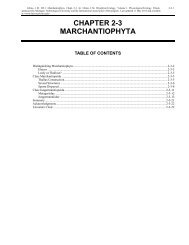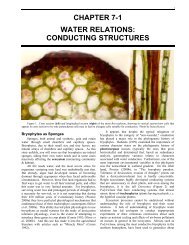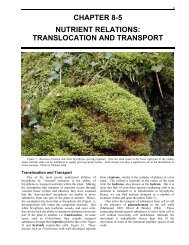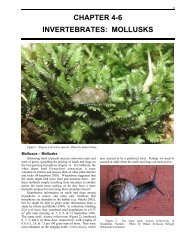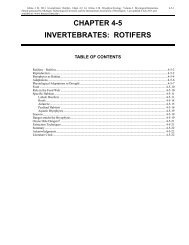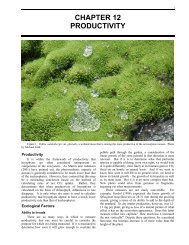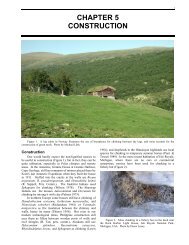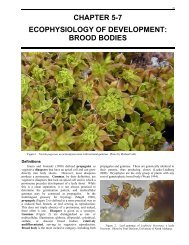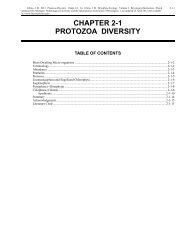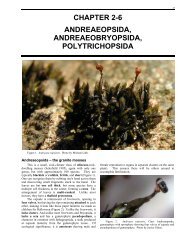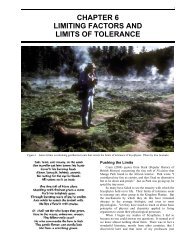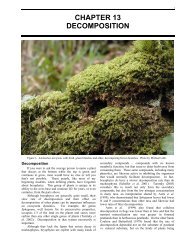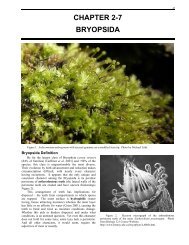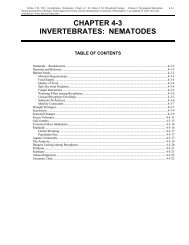chapter 5-9 ecophysiology of development: sporophyte - Bryophyte ...
chapter 5-9 ecophysiology of development: sporophyte - Bryophyte ...
chapter 5-9 ecophysiology of development: sporophyte - Bryophyte ...
Create successful ePaper yourself
Turn your PDF publications into a flip-book with our unique Google optimized e-Paper software.
Chapter 5-9: Ecophysiology <strong>of</strong> Development: Sporophyte 111foot mainly participating in water uptake from thegametophyte and the middle part mainly absorbingnutrients. Radiolabelled sucrose is known to travel bothdirections in these leptoids in Polytrichum commune(Eschrich 1975).Figure 11. Junction <strong>of</strong> gametophyte and <strong>sporophyte</strong> showinghaustorial foot <strong>of</strong> <strong>sporophyte</strong>. Drawn from Lal & Chauhan(1981).(Arnell 1905), spanning a multitude <strong>of</strong> environmentalconditions. When embryo <strong>development</strong> begins,environmental conditions can easily be less than favorablefor photosynthetic activity. Patterson and Baber (1961)found that many temperate mosses were dormant in latesummer and autumn. Such a dormant period, if it affectsthe <strong>sporophyte</strong> as well, greatly reduces its opportunity toprovide its own food. The <strong>sporophyte</strong> furthermore haslittle exposed surface area for photosynthesis, and whatsurface there is, at least throughout most <strong>of</strong> the<strong>development</strong>, has its long axis oriented in the samedirection as the light, thus minimizing its utility as a lightabsorbingorgan. It is reasonable, then, that thegametophyte, which is sensitive to moisture that must beavailable for growth and that has a large photosyntheticsurface, can provide the food and the signals for the<strong>sporophyte</strong>. Hughes (1954) has demonstrated that it is thegametophyte and not the <strong>sporophyte</strong> that responds tophotoperiod to control <strong>sporophyte</strong> <strong>development</strong> inPogonatum aloides and Polytrichum piliferum.In Fontinalis most species in the northeastern UnitedStates have mature gametangia in the autumn. This meansthat <strong>sporophyte</strong> <strong>development</strong> begins as the temperaturesdrop for winter (Figure 13). During my field observationsin New Hampshire, capsule maturity in Fontinalis novaeangliaeoccurred between February and April. By the end<strong>of</strong> April the capsules were gone. Under these coldconditions, productivity is reduced, although the greaterlight availability may <strong>of</strong>fset this low temperature effectsomewhat. By drawing on the reserves <strong>of</strong> the gametophyte,sufficient food could be provided for the wintertimecapsule <strong>development</strong>.Figure 12. Foot epidermal cell showing labyrinth in cell wall<strong>of</strong> Physcomitrium cyathicarpum. Drawing based on electronphotomicrograph in Lal & Chauhan (1981).Whereas the seta is little more than naked stem tissuerequiring minimal resources, the formation <strong>of</strong> the capsulecan be expected to have a high energy cost. Taylor andcoworkers (1972) have shown that in several liverworts the<strong>sporophyte</strong> has a higher concentration <strong>of</strong> chlorophyll thandoes the gametophyte. Yet the excised <strong>sporophyte</strong> requiresan exogenous carbon source, suggesting that it isnevertheless dependent on the gametophyte for at least part<strong>of</strong> its resources. Courtice and coworkers (1978) haveshown that sugars move from the gametophyte to the<strong>sporophyte</strong> in Physcomitrella. Apparently the demands <strong>of</strong>the <strong>sporophyte</strong> are greater than its own production capacity.If we put these demands into an ecological and temporalcontext, the need for a gametophytic supplement becomesobvious. For example, <strong>sporophyte</strong>s <strong>of</strong> Polytrichum canrequire up to 13 months to develop in some localitiesFigure 13. Seasonal cycle <strong>of</strong> Fontinalis dalecarlica and F.novae-angliae. Drawing by Janice Glime.In Polytrichum juniperinum and P. ohioense, thecapsule takes weight from the seta in culture if no dextroseis supplied to the capsule, but little seta loss occurs in thepresence <strong>of</strong> dextrose (Krisko & Paolillo 1972). Whenphotosynthetic <strong>sporophyte</strong> and gametophyte cultures <strong>of</strong>Physcomitrium pyriforme and Funaria hygrometrica aremaintained, only the gametophyte is autotrophic. Glucoseor some other sugar must be supplied to the <strong>sporophyte</strong> orall new growth lacks chlorophyll, produces a yellow wallpigment, and dies (Bauer 1963; Krupa 1969). Theseexamples all seem to demonstrate the high energyrequirement <strong>of</strong> the capsule and its dependence on thegametophyte.



